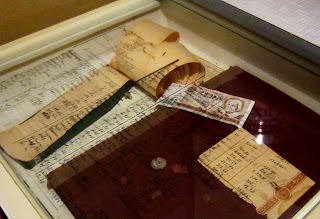The other night Drew and I decided to participate in Berlin's Lange Nacht der Museen event. We were able to wander freely into more than 80 participating museums until 2 am. Realistically, we were able to squeeze in 5, and I want to share one of our experiences with you - the DDR museum. Normally, we would never pay to go into the DDR museum, mostly because we were told there wasn't anything all to interesting in their presentation. Still, after attending, I recommend exploring the DDR section at the German history museum in Berlin instead. Either way, one display seemed relevant for a blog post - the kitchen of an East German apartment. For those of you who need a brief refresher class in history, the DDR is the Deutsche Demokratische Republik, a socialist state that was formed out of the occupied Russian zone of Germany after World War II. The DDR constructed the Berlin Wall which was intended to be an "anti-fascist" protection wall for East Germany that surrounded and cut off West Berlin from the rest of West Germany. West Berlin remained as a small island within the Soviet partition causing it to be a vulnerable place and the on the front line during the Cold War. During the DDR's 40 years of existence many tried to flee from the eastern block, however here is a glimpse into the life of those who stayed. Women were considered equal in the workforce in East Germany and were encouraged to take on qualified jobs as teachers, nurses and other care management roles. Women were able to further their education through night classes and children 11 weeks and older were automatically able to be enrolled in day care for free (by the government). This made daily life more manageable for a mother's dueling role as professional woman and housewife. Although this seemed rather progressive, men still had the decision making roles within society as well as leading positions in the workforce. Lives were constantly under the microscope by informants of the the Stasi. Neighbors, coworkers, spouses and children were all spying on each other to identify the non conformists of their society.
Many lived in fear by order and would live life simply by the rule to stay off the radar. East Germany was quite poor due to the war reparations therefore, products were often made from the cheapest, most uniform materials available. The picture below shows some of the kitchen tools in a typical DDR kitchen. It doesn't look too far off from what was available in the west, but there was only 1 - 2 choices rather than the variety of consumer products in a market based economy. To this day a few East German products have survived unification. One of my favorite items is the East German Mustard which is only 45 cents in the supermarket. Bautz’ner Senf is quite the treat for any bratwurst or pretzel and what was once state owned, is now in the hands of the a private company as one of the market leaders in mustard brands. The same original recipe is still used and you cannot beat the price. If you would like a further glimpse into East German life, I recommend watching The Lives of Others and Goodbye Lenin (both great movies). Fun fact: Angela Merkel, the current Chancellor is East German and has a degree in Physics. This October 3rd is the 20th anniversary of German Reunification.




No comments:
Post a Comment